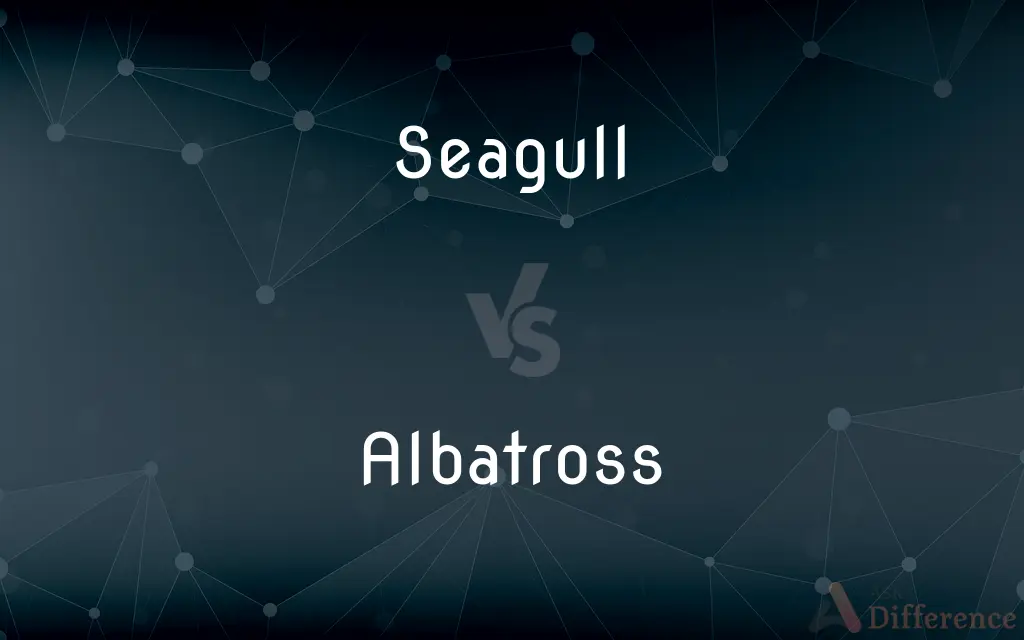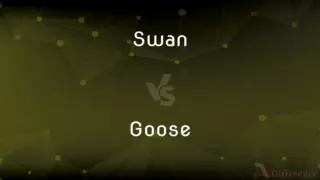Seagull vs. Albatross — What's the Difference?
Edited by Tayyaba Rehman — By Fiza Rafique — Updated on October 29, 2023
Seagull is a common coastal bird known for scavenging. Albatross is a large oceanic bird with impressive wingspan, often symbolizing a burden.

Difference Between Seagull and Albatross
Table of Contents
ADVERTISEMENT
Key Differences
Seagull is a term often used to describe various species of birds that primarily inhabit coastal regions. They are known for their adaptability and can often be found scavenging on beaches or near human settlements. Albatross, on the other hand, refers to a specific group of large seabirds that predominantly live in open oceans. They are particularly known for their remarkable ability to fly vast distances without flapping their wings, utilizing wind currents.
In terms of physical appearance, Seagulls are generally smaller and come in various colors, with gray and white being common. They often have a distinctive 'M' shaped pattern on their wings when seen from below. Albatrosses, conversely, are much larger, with some species boasting the longest wingspan of any bird. Their appearance is majestic, often characterized by a white body and dark wingtips.
From a behavioral perspective, Seagulls are known for their opportunistic feeding habits. They are commonly seen around landfills, harbors, or beaches scavenging for food. They can also be quite vocal and bold, often approaching humans if they expect food. In contrast, Albatrosses have a more refined diet, primarily consisting of squid and fish. They often spend a vast majority of their life at sea, coming ashore only for breeding.
Symbolically, the Albatross carries a unique literary significance. Derived from Samuel Taylor Coleridge's "The Rime of the Ancient Mariner," it represents a burden or curse. The Seagull, in popular culture, doesn't hold such a profound symbolic weight, but can sometimes be associated with freedom or opportunism, given its behavior.
In terms of conservation, both birds face challenges. Seagulls, due to their adaptability, often fare better in changing environments, though some species are at risk. Albatrosses, however, face significant threats from longline fishing and are among the most endangered of all birds, with many species at risk of extinction.
ADVERTISEMENT
Comparison Chart
Habitat
Coastal regions, near human settlements.
Open oceans, seldom near coasts.
Size and Appearance
Smaller, varied colors, 'M' pattern on wings.
Larger, long wingspan, white with dark wingtips.
Behavior
Opportunistic, scavenging, vocal.
Long-distance fliers, refined diet.
Symbolism
Sometimes symbolizes freedom or opportunism.
Often symbolizes a burden or curse.
Conservation Status
Generally adaptable, some species at risk.
Many species endangered, facing significant threats.
Compare with Definitions
Seagull
A bird adaptable to human environments.
The seagull perched on the car roof, eyeing the nearby trash can.
Albatross
A large seabird with a vast wingspan.
The albatross soared gracefully over the open ocean.
Seagull
A coastal bird often seen scavenging.
The seagull swooped down to grab the discarded sandwich.
Albatross
A seabird with a diet primarily of fish and squid.
The albatross dove into the water, emerging with a squid.
Seagull
A versatile bird of varied species.
A flock of seagulls circled the harbor.
Albatross
A symbol of burden or curse in literature.
His guilt was an albatross around his neck.
Seagull
A bird symbolizing freedom in certain contexts.
To her, the seagull represented the freedom of the open sky.
Albatross
One of the most endangered birds due to threats like longline fishing.
Conservationists are working hard to protect the albatross from extinction.
Seagull
A gull, especially one found near coastal areas.
Albatross
Albatrosses, of the biological family Diomedeidae, are large seabirds related to the procellariids, storm petrels, and diving petrels in the order Procellariiformes (the tubenoses). They range widely in the Southern Ocean and the North Pacific.
Seagull
Any of several white, often dark backed birds of the family Laridae having long pointed wings and short legs.
Albatross
Any of several large web-footed birds constituting the family Diomedeidae, chiefly of the oceans of the Southern Hemisphere, and having a hooked beak and long narrow wings.
Seagull
(orthography) The symbol ̼ , which combines under a letter as a sort of accent.
Albatross
A source of worry or distress.
Seagull
A fan or member of Brighton and Hove Albion Football Club.
Albatross
An obstacle to success.
Seagull
To run in the back line rather than concentrate on primary positional duties in open play.
Albatross
Any of various large seabirds of the family Diomedeidae ranging widely in the Southern Ocean and the North Pacific and having a hooked beak and long narrow wings.
Seagull
To use a British Seagull outboard.
Albatross
Any of various African and Asian pierid butterflies of the genus Appias. Some species of this genus are also known as puffins.
Seagull
(New Zealand) To work as a non-union casual stevedore.
Albatross
(golf) A double eagle, or three under par on any one hole, except a par 3 hole.
Seagull
Mostly white aquatic bird having long pointed wings and short legs
Albatross
(figurative) A long-term impediment, burden, or curse.
Seagull
A vocal bird known for its boldness.
The loud cries of the seagulls filled the air.
Albatross
A web-footed bird, of the genus Diomedea, of which there are several species. They are the largest of sea birds, capable of long-continued flight, and are often seen at great distances from the land. They are found chiefly in the southern hemisphere.
Albatross
(figurative) something that hinders or handicaps;
She was an albatross around his neck
Albatross
Large web-footed birds of the southern hemisphere having long narrow wings; noted for powerful gliding flight
Albatross
A bird known for its long-distance flights.
An albatross can fly thousands of miles without resting.
Common Curiosities
What is a Seagull's primary habitat?
Seagulls primarily inhabit coastal regions and areas near human settlements.
Which bird has a larger wingspan, Seagull or Albatross?
Albatrosses have a much larger wingspan compared to Seagulls.
Are Albatrosses often seen near coasts?
No, Albatrosses predominantly live in open oceans and rarely come near coasts.
What's the symbolic significance of an Albatross in literature?
In literature, an Albatross often symbolizes a burden or curse, as in "The Rime of the Ancient Mariner."
What's the primary diet of an Albatross?
Albatrosses primarily eat squid and fish.
How does a Seagull's vocal nature manifest?
Seagulls are quite vocal, often making loud cries, especially when scavenging.
Are Seagulls known for scavenging behavior?
Yes, Seagulls are known for their opportunistic and scavenging behavior.
Are all birds called Seagulls the same species?
No, "Seagull" is a general term that can refer to various species of gulls.
How many species of Albatross are there?
There are about 22 species of Albatrosses.
Are Albatrosses endangered?
Many species of Albatrosses are endangered, facing threats from longline fishing and other factors.
Can Seagulls be seen in inland areas?
While primarily coastal, Seagulls can sometimes be found in inland areas, especially near food sources.
How do Albatrosses manage long-distance flights?
Albatrosses utilize wind currents to glide and can fly vast distances without frequently flapping their wings.
Which bird, Seagull or Albatross, is more adaptable to changing environments?
Seagulls are generally more adaptable due to their opportunistic nature and varied habitats.
How do Seagulls interact with humans?
Seagulls are adaptable and can often be seen scavenging near human environments, sometimes even approaching people for food.
Do Albatrosses come ashore often?
Albatrosses primarily spend their life at sea, coming ashore mainly for breeding.
Share Your Discovery

Previous Comparison
Swan vs. Goose
Next Comparison
Receival vs. ReceptionAuthor Spotlight
Written by
Fiza RafiqueFiza Rafique is a skilled content writer at AskDifference.com, where she meticulously refines and enhances written pieces. Drawing from her vast editorial expertise, Fiza ensures clarity, accuracy, and precision in every article. Passionate about language, she continually seeks to elevate the quality of content for readers worldwide.
Edited by
Tayyaba RehmanTayyaba Rehman is a distinguished writer, currently serving as a primary contributor to askdifference.com. As a researcher in semantics and etymology, Tayyaba's passion for the complexity of languages and their distinctions has found a perfect home on the platform. Tayyaba delves into the intricacies of language, distinguishing between commonly confused words and phrases, thereby providing clarity for readers worldwide.














































